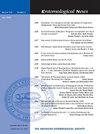Brassica carinata: New Reproductive Host Plant of Bemisia tabaci (Hemiptera: Aleyrodidae)
IF 0.4
4区 农林科学
Q4 ENTOMOLOGY
引用次数: 2
Abstract
ABSTRACT: A laboratory experiment was conducted on two potential reproductive host plant species of the whitefly Bemisia tabaci (Gennadius). The two plant species, Brassica carinata A. Braun (carinata or Ethiopian mustard) and Myrica cerifera L. (southern wax myrtle), were considered for study as potential overwintering host species for B. tabaci because of their presence with green foliage in the southeastern United States agricultural community from the fall through spring season. The Middle-East-Asia Minor 1 of the cryptic whitefly species group of B. tabaci survives the mild winters in the southeastern United States. In this study, B. carinata was demonstrated to be a favorable host plant for B. tabaci. Based on a no-choice experiment, oviposition, egg hatch, and survival to the adult stage were similar for whiteflies on B. carinata as compared with collard (B. oleracea var. acephala de Condolle), a known favorable host for B. tabaci. However, results from a dual choice experiment indicated that the whiteflies preferred B. carinata to B. oleracea for feeding and oviposition. Conversely, although southern wax myrtle served as an ovipositional host, the ovipositional performance of B. tabaci in a no-choice assay was over eight-fold less than on B. carinata, and nymphal survival was not successful beyond the second instar on southern wax myrtle in a laboratory experiment. However, a few nymphs survived to the fourth instar on intact plants of southern wax myrtle in the landscape. The results of this study have implications on whitefly population dynamics. Winter populations of B. tabaci are suppressed in the field, but plant species, such as carinata or collard, that are present during the mild winter may help support a buildup of whiteflies during the spring.芸苔:烟粉虱新的繁殖寄主植物(半翅目:烟粉蝶科)
摘要:对两种具有潜在繁殖潜力的烟粉虱寄主植物进行了室内试验。这两个植物物种,芸苔属(Brassica carinata A.Braun)(carinata或埃塞俄比亚芥末)和杨梅属(Myrica cerifera L.)(南蜡桃金娘),被认为是烟粉虱的潜在越冬寄主物种,因为它们在美国东南部的农业群落中从秋季到春季都有绿叶。在美国东南部的温和冬季,小东亚烟粉虱的一个隐蔽的粉虱种群存活下来。在本研究中,隆突B.carinata被证明是烟粉虱的有利寄主植物。根据一项无选择实验,与羽衣甘蓝(B.oleracea var.acephala de Condole)相比,白粉虫在隆鱼身上的产卵、孵化和成年期的存活率相似,羽衣甘蓝是已知的烟草的有利宿主。然而,双重选择实验的结果表明,在觅食和产卵方面,粉虱更喜欢隆突B.carinata而不是甘蓝B.oleracea。相反,尽管南方紫薇是产卵宿主,但在无选择试验中,烟粉虱的产卵性能比隆虫低8倍多,在实验室试验中,若虫在南方紫薇2龄以上的存活率并不成功。然而,在景观中,少数若虫在完整的南方蜡金娘植物上存活到四龄。这项研究的结果对白蝇种群的动态具有启示意义。烟粉虱的冬季种群在野外受到抑制,但在温和的冬季出现的植物物种,如隆尾虫或羽衣粉虱,可能有助于支持春季粉虱的繁殖。
本文章由计算机程序翻译,如有差异,请以英文原文为准。
求助全文
约1分钟内获得全文
求助全文
来源期刊

Entomological News
生物-昆虫学
CiteScore
1.10
自引率
25.00%
发文量
17
期刊介绍:
Contributions are accepted on any of the aspects of systematics and taxonomy of insects. This includes: taxonomic revisions, phylogenetics, biogeography and faunistics, and descriptive morphology of insects. Taxonomic papers describing single species are acceptable if such a study is sufficiently justified, however, comprehensive studies that provide a comparative, integrated study of insect systematics and taxonomy will get priority.
 求助内容:
求助内容: 应助结果提醒方式:
应助结果提醒方式:


